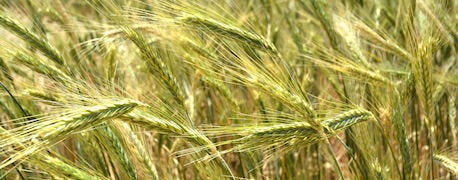June 13, 2014

For beef producers in the Rolling Plains, triticale could be a superior option over wheat or oats, according to Jason Baker, Texas A&M AgriLife Research senior research associate in Amarillo, Texas, who has been conducting trials since 2002.
Triticale is a cross between wheat and rye, Baker explained. It was first developed in the late 1800s, but the first commercial releases were not available until the 1960s. Triticale grows taller and remains green longer than wheat.

Texas A
"We've been working several years here to make better varieties for the Rolling Plains," he said during a recent field day near Chillicothe, Texas. "We don't see triticale competing for the wheat acres. It's really a complement to dual-purpose wheat. We are trying to use the triticale more for grazing and not put as much pressure on our wheat, allowing us to use the wheat more for grain and triticale for forage."
"Anyone who grazes wheat or uses wheat for hay might want to at least have some triticale in their program," he said. "You can plant the triticale earlier and turn cattle in and save the wheat for grain later on. If you have a lot of growth, you can graze the wheat some, but use the triticale as your main focus for grazing."
Continue reading after the jump >>
~~~PAGE_BREAK_HERE~~~
Working with about 20 experimental lines and 100 commercially available triticale lines in breeding trials, Baker said he also has compiled eight years of forage yields data comparing triticale, wheat, oats and barley.
The most recent three-year total average resulted in the triticale varieties yielding 2.09-2.11 tons per acre dry matter, compared to 1.69-1.93 tons per acre for wheat, 1.61-1.79 tons per acre for oats, and 1.54-2.01 tons per acre on barley.
In 2014, the triticale – after three clippings – yielded considerably better under drought and late freeze conditions, he said. The triticale yields were 1.92-2 tons per acre compared to wheat at 1.26-1.58 tons per acre, oats at 0.88-1.17 tons per acre and barley at 1.13-1.44 tons per acre.
"Triticale tops that test here in the Rolling Plains," he said. "Our breeding plots have oats and wheat planted next to the triticale, and you can look at the difference – oats had a lot of freeze damage. The wheat is shorter and just produces less forage."
Baker said the two Texas A&M AgriLife varieties in the forage trial are TAMcale 6331 and TAMcale 5019, "but if you took any good commercial triticale variety, you will get the same results for grazing, hay or silage. They produce a much greater quantity."
"Many triticale varieties have disease and insect resistance that wheat and oats don't have, allowing us to plant a little earlier in the year," he said. "We can get cattle on sooner by taking advantage of some of the late summer rains that we might get and go ahead and get it in the ground and get a good stand."
In addition to the earlier stand in the fall, Baker said triticale offers two to three weeks longer grazing time in the spring.
Source: Texas A&M
You May Also Like




